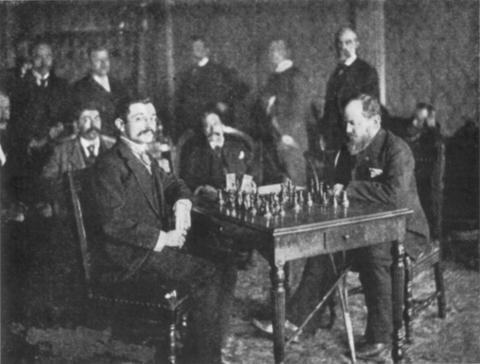After Steinitz’s successful title defence against Chigorin in 1892, chess world already started seeking the next challenger. Three names appeared as only real rivals – Siegbert Tarrasch, winner of multiple international tournament, Mikhail Chigorin, who was always „there somewhere“ and the young and ever improving Emmanuel Lasker, who scored stable victories in two modest English tournaments in 1892 and who defeated Blackburne and Bird in matches.

Lasker realized that he has to make a real breakthrough in order to have a genine shot at a World Championship title. Thus, he issued a Tarrasch an official match challenge. However, Siegbert Tarrasch was particularly unimpressed with Lasker’s results. He refused to play in the match, explaining that: „He would accept challenge only when the ‘young man’ had taken first place in a strong international tournament. „ (Source: Garry Kasparov On My Great Predecessors, Part one, page 120).
Tarrasch went on to play a match against Chigorin instead. But Lasker found himself in a stalemate. There were no international tournaments. So he decided to go on a long tour of America, where he beat local masters in matches and scored an impressive 13/13 victory in the New York 1893 tournament. After this success, he officially challenged Steinitz to a match (while Tarrasch and Chigorin were only preparing for their ‘final Candidates match’). Steinitz, who claimed that his match against Chigorin will be his last, accepted the challenge, since he never refused a fight.
The match was played between 13 March and 26th May in 1894, in New York, Philadelphia and Montreal. Although the New York part of the match ended on equal terms, with each players scoring two wins, Lasker virtually won the match in Philadelphia, by scoring five consecutive wins. Apart from losing the 7th game in which Lasker turned inferior position around, Steinitz had serious problems in queenless middlegame positions, which he handled uncertainly. Lasker’s success was largely based on his psychological employment of opening variations.
In the Montreal part of the match, Steinitz gained some ground, but he was so helplessly behind he was unable to make a comeback. By winning the 19th game, Lasker won the match 10-5 in terms of decisive games (with 4 draws). Thus, Steinitz’s reign was ended and the world got a new World Champion, whose tenure would last for the next 27 years.
True, the world would not recognize Lasker the true champion so quickly, claiming that victory over 58-year old Steinitz was not an impressive feat. During the next two years, he would have to prove his worth in numerous chess tournaments and his rematch against Steinitz.

